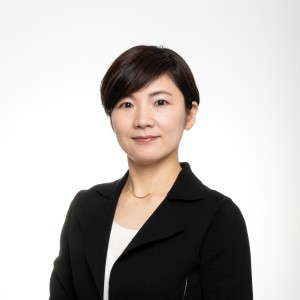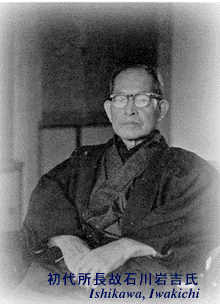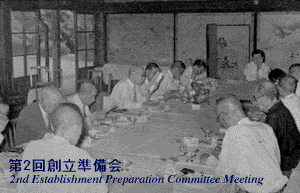- TOP
- Research
- Education and Research Facilities
- The Institute for Japanese Culture and Classics
- The Institute for Japanese Culture and Classics
- Kokugakuin Academic Resource Center (Archeology)
- Kokugakuin Academic Resource Center (Shinto)
- University History and Academic Asset Research Center
- Center for Promotion of Excellence in Research and Education
- Kokugakuin University Museum
- Center for Kojiki Studies
The Institute for Japanese Culture and Classics
Updated on Jun 01 2025
http://www2.kokugakuin.ac.jp/oardijcc/
Kokugakuin University established the Institute for Japanese Culture and Classics in 1955 to conduct high quality research on Japanese culture, compare the results with many other cultures of the world, and grasp the fundamental quality and variety of Japan’s culture. In 2007, the Institute became a part of the Organization for the Advancement of Research and Development along with three other organizations. It maintains its name as the Institute for Japanese Culture and Classics and functions as a research organization within the Organization for the advancement of Research and Development. In 2015, the Institute celebrated its 60th anniversary.
In line with the purpose and goals of the establishment of Kokugakuin University, the goals of the Institute for Japanese Culture and Classics are to elucidate the fundamental quality of Japanese culture by conducting research on issues related to research on Japanese culture and the beliefs and philosophies of the Japanese public through wide-reaching and comprehensive scholarship, and to promote exchanges, collaboration, and mutual understanding among researchers from Japan and overseas.
To achieve these goals, the Institute for Japanese Culture and Classics:
- Conducts research on Shinto, Japan studies, religious culture, and related areas;
- Publicizes academic information;
- Holds lectures and seminars;
- Conducts exchanges and collaborations with domestic and international research institutions; and
- Carries out any other projects deemed necessary by the Institute.
In order to execute the above activities, the Institute has established two divisions:
- The Shinto and Japan Studies Research Division; and
- The International Exchange and Academic Information Communications Division.
Message from Our Director

The Institute for Japanese Culture and Classics celebrated its 60th anniversary in fiscal 2015.
The Organization for the Advancement of Research and Development (OARD) was established in 2007 in a form that would encourage the further development of the Institute, which was now positioned under the OARD. The Institute in turn established two units–the Shinto and Japan Studies Research Division and the International Exchange and Academic Information Communications Division–with each planning its own respective research projects and otherwise promoting research.
The Shinto and Japan Studies Research Division is responsible for forming a network involved with and conducting historical research on Shinto and Japan studies (Kokugaku) so as to create a hub for research on Japan studies, the traditional focus of study at Kokugakuin University. The International Exchange and Academic Information Communications Division operates a Digital Museum through which information is distributed digitally regarding the scholarly resources available at the University and the results of research conducted at the OARD. This Division also oversees international scholarly exchanges through the creation of materials related to Shinto culture and the holding of international scholarly forums.
The full-time faculty and researchers attached the Institute along with affiliated faculty from other units continue working together to carry on the more than six decades of history and traditions of scholarship the Institute has accumulated while also internationally disseminating about research on Japanese culture in a manner appropriate to the modern research environment.
We plan to make further efforts through the Institute’s research activities toward nurturing the abilities of junior scholars to conduct and present their work internationally, and toward doing our part to further improve the quality of research on Japanese culture as a whole.
Professor Kikuko Hirafuji
Director, Institute for Japanese Culture and Classics
Organization for the Advancement of Research and Development
Kokugakuin University
Purpose of Establishing the Institute for Japanese Culture and Classics
The purpose of establishing this Institute is to conduct high quality research on Japanese culture; to compare the results with many other cultures of the world; and to grasp the fundamental quality and variety of our national tradition.
In the Second World War, which stemmed from tragic rivalries among humanity, Japan met a defeat unparalleled in our national history. The Japanese people, who were confronted by the complete collapse of social organization and national life, nearly sank into cultural despondence and moral apathy. As a result, in the path to rebuilding the country there is a noticeable trend towards being satisfied with the transplanting of foreign culture and customs. Our characteristically rich tangible and intangible national cultural assets have not been properly understood, nor has our traditional life-style been sufficiently reevaluated.
Humans are the product of history, society, and culture. The character of contemporary Japanese people has been constructed within a long and particular historical tradition that has been refined through a process of adaptation and the expansion of the natural conditions of the climate and land of Japan, and of the cultures of neighboring peoples which have been brought into Japan from long ago. No one can ignore this fact in discussing Japan. In modern times, in contrast, many countries in Europe and the Americas have had an extraordinary interest in the arts and life style of our country. Even though the superficial imitation of foreign culture buys a frown from conscientious and well-bred foreigners and Japanese, to the contrary, it has to be thought that Japan, which began as a cultured nation, should seek out its traditional self-reflective and fostering roots as the means to earn support in the world. This means that in order to advance their level of living Japanese people must accept the necessity for having an interest in and for reflection upon tried and tested Japanese cultural patterns and life-style by virtue of knowing the true Japan and of their own subjective judgment. Again along these lines, a Japanese adaptation of the strong points of foreign cultures will be required.
This was already a concern of our predecessors in the earlier years of Meiji period when foreign civilization was being transplanted wholesale to Japan. The rationale for creating Kokugakuin University also lies here. However, compared to that time, the present state of affairs is quite a lot more serious. We must be extremely anxious about the future of Japanese culture.
As a rule, the study of a country’s special characteristics are never sufficiently made clear when that country’s culture alone is studied unilaterally. Commonality and contrasts are initially identified in comparative research with the history and traditions of another culture and thereby a culture’s special characteristics become clear. With regard to Japanese culture also, a researcher must study Japanese culture deeply in order to elucidate its essence while at the same time keeping an eye on the cultures of foreign countries, and from the standpoint of modern thought become cognizant again of traditional Japanese morals and values. It is from research that is conducted from this kind of wide perspective that we can for the first time reasonably expect the wholesome growth and development of Japanese culture. In this we depend on the efforts of sympathetic individuals. I anticipate that the newly established Institute for Japanese Culture and Classics at Kokugakuin University will become a center of scholarship as it expands and deepens existing research.
The principle research of the Institute will be:
- Basic studies of Japanese culture
- Studies of various questions related to the Japanese people’s faith and morals.
And the content of the activities will be:
- Scholarly investigations and research and the promotion of such investigations and research
- The accumulation and preservation of domestic and foreign books and documents
- The publication and presentation of research; holding public lectures
- Maintaining contacts with other domestic and foreign research organizations and exchanging materials with them
- Any activities necessary for achieving other objectives.
The Institute will also try to accommodate foreign researchers, to have presentations for the mutual exchange of research results, and to assist in promoting international good will.
As an important research organization for Japanese spiritual culture in post-war Japan, we will proceed with these activities. If we can realize their results, then, I believe, it will be an enormous service to domestic and international cultural progress. I sincerely hope for the cooperation of informed people.
Ishikawa Iwakichi
Executive Director,
Kokugakuin University
April 1955
History of Establishing the IJCC
(reprinted from the Twentieth Anniversary Bulletin)
Plans to Establish IJCC

The idea to establish the Institute for the Study of Japanese Culture and Classics at Kokugakuin University was advanced in the early 1950’s under the direction of Dr. Ishikawa, the university’s president. It goes without saying that in the Japan of that time, having yet to emerge from the confusion of regaining independence after nearly six years of occupation by the Allied Forces nor from the confusion brought about by the collapse of their sense of values and social structure, the public interest in and regard for traditional Japanese culture was not very high. Under the so-called “Shinto Directive” Kokugakuin University was ordered to abolish its main project – the Research Center for Japanese Classics (Kôten Kôkyûjo). Overcoming its reservations in judgment, the university changed over to a new curriculum and among other things established a graduate school program. Gradually, things began to fall in place. President Ishikawa, who had been anxious over the restoration of the national spirit and the future of Kokugakuin University, hoped to establish a new research facility for developing the existing academic tradition and inheriting its spirit of research, which would parallel and expand on the education and research in undergraduate departments.
As an early trial, there was a plan sometime prior to 1953 for an Institute for the Study of the Imperial Way (Kôdô Kenkyûjo) (its tentative name). This plan, whose drafter and date are both unknown, never progressed beyond being a mere idea, although it appears that an incorporated foundation was established from among talented individuals both inside and outside the university for the purpose of “Research on Japanese Classics, the Dissemination and Publicity of Imperial Way Thought, Supplemental Training for Scholars and Students,” and so on.
In the 1953-4 academic school year, shortly after Japan re-emerged as an independent nation, a more concrete plan appeared in the form of “Incorporated Foundation, Institute for Japanese Culture and Classics” or “Kokugakuin University Institute for Japanese Culture and Classics.” At that time, Superintendent Fukuda Harutomo, a close associate of President Ishikawa, and friend of Kokugakuin’s pre-war superintendent Akashi Teruo, was sympathetic to the President’s petition. More concrete suggestions were refined and it was proposed to push forward. According to the dual suggestion, it was planned that the Institute would be an incorporated foundation that would have a neutral relationship with Kokugakuin University; while in the event of adverse circumstances, it would be attached to the university with the intention of gauging its development. Its purpose was “principally to conduct serious research in Shinto Studies, Japanese literature, and Japanese history in order to elucidate the essence of Japanese culture and promote its exalted development; and to raise Japanese culture to its previous level.” Furthermore, the university’s Operations Department would oversee all the business concerning the Institute’s establishment; the office of Institute Director would be held by the university’s Executive Director; the operational expenses and budget would receive the approval of the university’s Board of Directors; and given the university’s own financial foundation lack of strength, general operational expenses, building expenses, book expenses, and the like would be covered by fixed endowments for the business community and others.
Concerning the plans for the establishment of the Institute, the scholars who the President consulted were at that time lecturing in the Graduate School: Yanagita Kunio, Kishimoto Hideo, Kôno Seizô, and the Dean of the Humanities College Takeda Yûkichi. However, Professor Kishimoto could not yet participate fully at this stage because he was lecturing overseas for about a year beginning in September 1953. On the executive board were: directing general operations – Matsuo Saburô, Kobayashi Takeji, Tanaka Kihô; executive director – Nakamura Shirô; superintendent – Fukuda Harutomo; and counselor – Fujii Minoru. Within the year, they wrote the provisional prospectus and budget for establishing the Institute and studied the feasibility of opening the Institute in April 1954. Fukuda, Fujii, and Nakamura also organized the Ichikinkai (“First Friday Club”) with sympathizers from the financial circles of the Industrial Club Shimizu Kiyoshi, Senda Kanbei, and Takahara Takeo among others. They met on the first Friday every month for consultation on fund raising. In spite of these efforts, no progress was seen in the area of fund raising in the business community because the post Korean Conflict domestic economy was tending to deflation. Under such conditions, it first of all became necessary to implement even just a portion of the project, so a loan from the Grand Shrine of Ise was requested. The President personally drafted the request.
The IJCC Establishment Committee

Following that, the situation changed somewhat for the better. The chairman for the Rockefeller Foundation’s Department of Humanities Dr. Charles B. Fahs, who had previously contacted Professor Kishimoto, was asked to help in establishing the Institute when he visited in the Spring of 1954. In September, a voucher for a $3,000 purchase of foreign texts was received. With this as a turning point, in November, 500,000 yen was donated to the development fund by the Grand Shrine of Ise. From the Fall of 1954, luck finally began to get better. Then at the end of November, Hirai Naofusa, who just returned from studying in the United States, took charge of the operations concerning the establishment of the Institute. With the hanging of a placard reading “Office for Preparing the Establishment of the Institute” in a corner of Professor Yanagita and Hori’s office on the second floor of the old school building the first real office was opened.
The first official office was opened after the purchase of philosophical and religious studies texts with the funds donated by the Rockefeller Foundation. With the cooperation of the Foundation about 390 volumes were received by the end of the 1956-7 academic year. From the New York Japan Cooperation Society, which is aligned with the Rockefeller Foundation, there was a library donation pledge and 340 volumes arrived. Furthermore, from the Cultural Attaché for the US Embassy Glen W. Shaw and the former Ambassador Francis S. G. Piggott there were donations of considerable educational and historical texts. With regard to the donation of books from abroad, the responsibility borne by Professors Kishimoto Hideo and Fujii Minoru was great.
Due to President Ishikawa being bedridden there were some unavoidable delays, but the general plan for the Institute’s organization and administration were laid out through the good will of Kishimoto Hideo, who had returned to Japan and was recuperating from an illness contracted in the US. The President finally recovered his health and the 1st Establishment Preparation Committee Meeting was held on May 17, 1955 for all the heretofore concerned principals. At this meeting the plan for the Institute presented by Professor Kishimoto was adopted and committees were formed for research guidance and financial matters. The members of the Research Guidance Committee (later renamed the Research Review Committee) included: Yanagita, Kishimoto, Kôno, and Takeda; the Financial Affairs Committee had nine members: Matsuo, Kobayashi, Tanaka, Fukuda, Fujii, Nakamura, Shimizu, Senda, and Takahara. At that time the fundamental direction of Institute’s activities was discussed. The main points were as follows:
- For the present, emphasis will be put on research on the spiritual culture of Japan, especially, as the first objective detailed and comprehensive research is to be conducted on koyû shinkô (indigenous beliefs).
- Banpô muhi shugi (ultranationalism) will be excluded and the autonomy of scholarship that is politically neither left nor right will be guaranteed (especially emphasized by Professor Yanagita).
- While deeply pursuing research on the domestic side on the one hand, comparative studies will be made with a variety of foreign countries from a wide perspective (especially emphasized by Professor Kishimoto).
- A period of employ will be set established for researchers and they will be required to submit their academic work for publication within that period.
On June 17, the 2nd Establishment Preparation Committee Meeting was held in the Constitution Room of the Meiji Kinen Kan building. In anticipation of the establishment of an Incorporated Foundation, the Institute’s Board of Directors was elected: from the academic world – Kishimoto Hideo and Takeda Yûkichi; from the Financial Affairs Committee – Fujii Minoru and Senda Kanbei; and from the university Ishikawa Iwakichi, Matsuo Saburô and Fukuda Harutomo. Also elected at this meeting were: as Institute Director – President Ishikawa; and as Chair – Hirai Naofusa. The main work of the Institute as a whole was consolidated into two articles (see below). The Establishment Preparation Committee met once more on July 1 at the same location. At that meeting the establishment prospectus and the Institute’s bylaws were discussed and the date April 1955 was inscribed. In that the prospectus sets forth the purpose for establishing the Institute.
Contact: Public Relations Office
RECOMMENDS
-
{{settings.title}}
{{settings.lead.title}}
{{{settings.lead.letter}}}
{{pages.title}}
{{articles.title}}
Language
SEARCH
{{section.title}}
-
{{item.tagline}}

